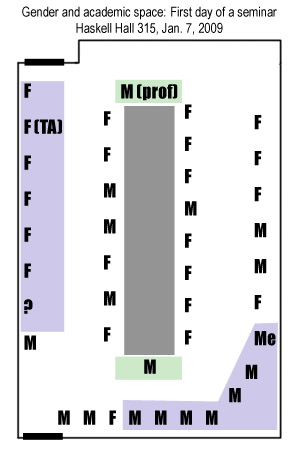Here is a diagram of how students arranged themselves around the room, on the first day of a seminar that happened to be on space and place. It reveals an obviously gendered system of spontaneous spatial organization.

Incidentally, if you count, this comes to 18 males (prof included) and 23 females (TA included), i.e., 44% male and 56% female. The “Me” is yours truly, and the “?” is someone who may or may not have been sitting across from me, but was masked, in any event, by someone else’s head. In any event, the “objective” gender balance isn’t that far from even.
We see here, first and foremost, a striking emergence of same-sex spatial blocs (colored lavender): a large male block is in the bottom right corner, while a large female bloc is in the upper left. Elsewhere in the room, the seating was more mixed by gender.
Why might we see this pattern? Is it because certain academics simply prefer to sit beside people of the same sex? Surely many academics are conscious of gender and sexuality in public settings, and in choosing who to associate with among strangers. This was the first day of class, after all.
Or we could consider a more plausible hypothesis: does this pattern emerge because academics sit near people they know or are friends with? Certainly, when I enter a public space, I try to sit with my friends, and in this case I actually came in with friends. On this hypothesis, we might observe gendered spatial arrangement as a result of certain academics preferentially developing same-sex friendships. Such a pattern has been around in anthro grad school since the 60s and 70s, according to Susan Philips, and I think it continues today, insofar as many academic friendships are shaped by long-lasting sexual competition or collaboration, difference or solidarity, sexual desire or disinterest…
Also, we have to consider the extent to which gender is merely the expression of other forms of social organization. In this room there was a very salient, collectively recognized difference between the Anthropology Department doctoral students and the Social Science Master’s students (MAPSS). For instance, the bloc of males in the bottom right was all doctoral students, if I recall correctly. We can’t really analyze this here, for lack of knowledge of prior relationships in the room, but it’s interesting that space gets structured into blocs without anyone having a conscious will to create such structures. That a general spatial organization can emerge from a number of little personal decisions about who to be proximate with.
Gender in this space did not seem difficult to decode, on a crude level. I read it off from footware, from hats, from coats, from the length and shape of their hair, the tone and pitch of their voices. People seemed content to perform their genders in unambiguous fashion. I should emphasize: I’m not saying that “M” or “F” exhausts what there is to say about gender; it’s a crude and simplistic categorization and it needs to be generally resisted. But the sad fact is: this crude binary categorization captures real patterns in the social world.
For instance: the symbolically central space, of course, was occupied by the male professor, the “head” of the table (colored green). In an odd visual reflection of this spatialization of male authority, the foot of the table was occupied by a male student too. That guy happens to be a friend of mine, and he has long had a habit of sitting in that seat in this particular room. I don’t know if gender has much to do with that habit.
Perhaps, then, there’s no gendered pattern to read in this reflection, just contingency into which observers can project their own predetermined symbolic structures; perhaps it’s a mistake to read symbolic structure directly out of the empirical circumstances, as I’m doing; perhaps the real gendered dynamics of the room have little to do with the seating chart. Perhaps I’m ascribing structure that is meaningless to the participants (except me). Certainly, it would be hard to detect a direct link between participants’ genders and the academic conversation that subsequently took place.
The problem with analyzing gender in academia is an inescapable tension between gender as a hermeneutic that one uses to ascribe order to an indeterminate social situation, and gender as a deep structure that brings prior order to the world in unconscious and unnoticeable ways. Gender is a thing one invokes contingently, perhaps wrongly, in making sense of the social world; but it’s simultaneously what determines and regulates that world prior to anyone’s perception or action.
Feeling silly and reflexive, I said at the beginning of class when we went around: “I work on anthropology of universities. This week I’m especially interested in the gendered organization of academic discourse.”
People laughed.
Apparently the thought of social determination and gender provokes laughter. The only question is: is it the laughter of recognition or the laughter of disavowal?